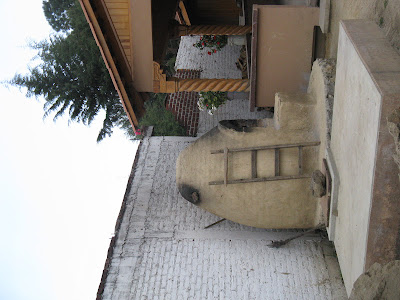March 21, 2012
Our aversion to driving in or around Guadalajara began the day in 2010 when we were trying to skirt around the city as we drove north to south. Our GPS guided us into the heart of the metropolis, spouted a few nonsense instructions, and then blithely announced, "No data is available for your current location."
This year we poked our nose into Guadalajara to buy building supplies at Home Depot. The navigator (me) missed a crucial turn and we spent the next 45 minutes trying to find our way back to the key junction. Round and round we went. The GPS would count down the kilometres and we'd be really close, possibly even in sight of that huge Home Depot sign. Then, Jim would chicken out on a right-side merge down a steep sloop into a 3-lane lateral, and the km would start to ratchet up again. Or the GPS did not account for an exit that had been closed off since the last map update. At one exciting moment, we were driving along with four lanes of traffic in each direction, when the GPS instructed us to get into the left lane and announced, "
left turn in 800 metres". Oh sure. But it was quite right -- there was a special overpass to allow hapless drivers to double back to where they should have been. Exciting times.
[That day I did something I never did before in my entire life. When we finally got to the store, I poured a shot of tequila and tossed it back before I could face shopping. Don't tell Mother.]
My point is that we are utterly phobic about Guadalajara and would do anything to avoid a route that included the city's periferico or ring road. How then to drive west toward the coast? When we heard of a park in a rural Etzatlan that could be reached by travelling south of the city we decided it was for us. It also made for a short run on our first day out of the Lake Chapala area. Alas, less than an hour from our destination, Tomi (nickname for the female voice who torments us through our TomTom unit) took us on a creative shortcut. The low point was when we found ourselves on an actual, literal cowpath. We persevered (NEVER go back is my attitude) and got to a tiny crossroads. An elderly woman and a young boy were quite unable to offer assistance. I don't believe they understood us when we said 'Etzatlan', but in any case, people who don't drive cars are often unable to help with road directions.
 |
| Should have followed the sugar-cane truck. |
I can say with some confidence that we were the first RV to navigate through several of the narrow lanes we traversed during the afternoon. The total time we were off-road was not long, but it was a bit worrying. Would we reach a place we could not get through and have to retrace our path? Eventually we found ourselves in a village where some of the approaching traffic was bigger than Vagrant Van. A little while later we connected with a wider road. Saved again.
Delia's RV Park was a welcome sight. It is run by a woman called Bonnie, so it had to be good. It is a park in every sense -- trees, a grassy field and lots of animals. Several of the resident dogs came to visit during the evening, once word got around that Jim was distributing treats.
 |
| Hard to spot, but there are two iguanas in this picture. |
The horses were curious, but spurned my withered carrots.


















































